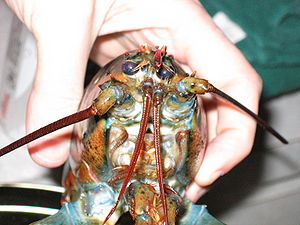
There is a scientific debate which questions whether crustaceans experience pain. It is a complex mental state, with a distinct perceptual quality but also associated with suffering, which is an emotional state. Because of this complexity, the presence of pain in an animal, or another human for that matter, cannot be determined unambiguously using observational methods, but the conclusion that animals experience pain is often inferred on the basis of likely presence of phenomenal consciousness which is deduced from comparative brain physiology as well as physical and behavioural reactions.[1][2]
Definitions of pain vary, but most involve the ability of the nervous system to detect and reflexively react to harmful stimuli by avoiding it, and the ability to subjectively experience suffering. Suffering cannot be directly measured in other animals. Responses to putatively painful stimuli can be measured, but not the experience itself. To address this problem when assessing the capacity of other species to experience pain, argument by analogy is sometimes used.
Crustaceans fulfill several criteria proposed as indicating that non-human animals may experience pain. These fulfilled criteria include a suitable nervous system and sensory receptors; opioid receptors and reduced responses to noxious stimuli when given analgesics and local anaesthetics; physiological changes to noxious stimuli; displaying protective motor reactions; exhibiting avoidance learning; and making trade-offs between noxious stimulus avoidance and other motivational requirements.
In vertebrates, endogenous opioids are neurochemicals that moderate pain by interacting with opioid receptors. Opioid peptides and opioid receptors occur naturally in crustaceans, and although it was concluded in 2005 "at present no certain conclusion can be drawn",[3] more recent considerations suggest their presence along with related physiological and behavioural responses as indicating that crustaceans may experience pain.[4][5] Opioids may moderate pain in crustaceans in a similar way to that in vertebrates. If crustaceans feel pain, there are ethical and animal welfare implications including the consequences of exposure to pollutants, and practices involving commercial and recreational fishing, aquaculture, food preparation and for crustaceans used in scientific research.
- ^ Abbott, F.V., Franklin, K.B.J. and Westbrook, R.F. (1995). "The formalin test: Scoring properties of the first and second phases of the pain response in rats". Pain. 60 (1): 91–102. doi:10.1016/0304-3959(94)00095-V. PMID 7715946. S2CID 35448280.
{{cite journal}}: CS1 maint: multiple names: authors list (link) - ^ Key, B. (2015). "Fish do not feel pain and its implications for understanding phenomenal consciousness". Biology and Philosophy. 30 (2): 149–165. doi:10.1007/s10539-014-9469-4. PMC 4356734. PMID 25798021.
- ^ Cite error: The named reference
Sømmewas invoked but never defined (see the help page). - ^ Cite error: The named reference
Dyuizenwas invoked but never defined (see the help page). - ^ Cite error: The named reference
Elwood2015was invoked but never defined (see the help page).